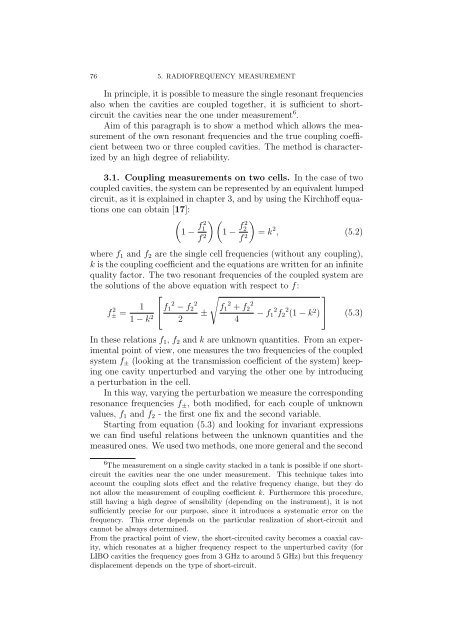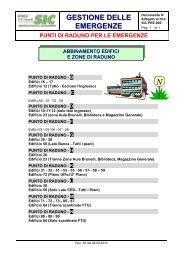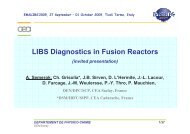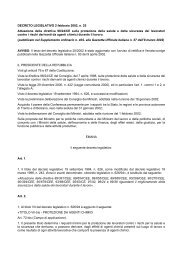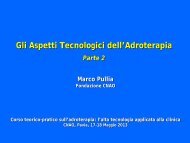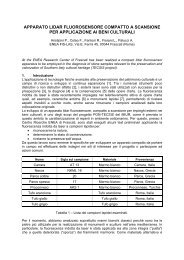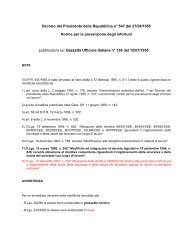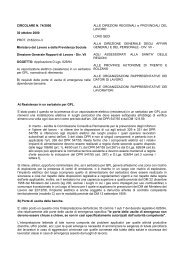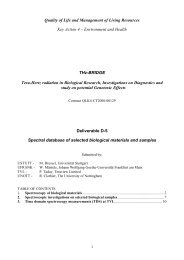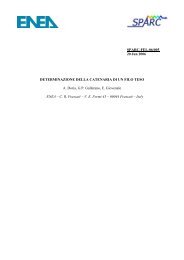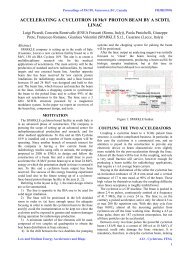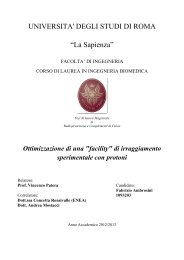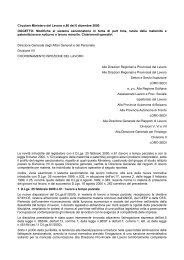Theory, Design and Tests on a Prototype Module of a Compact ...
Theory, Design and Tests on a Prototype Module of a Compact ...
Theory, Design and Tests on a Prototype Module of a Compact ...
Create successful ePaper yourself
Turn your PDF publications into a flip-book with our unique Google optimized e-Paper software.
76 5. RADIOFREQUENCY MEASUREMENT<br />
In principle, it is possible to measure the single res<strong>on</strong>ant frequencies<br />
also when the cavities are coupled together, it is sufficient to shortcircuit<br />
the cavities near the <strong>on</strong>e under measurement 6 .<br />
Aim <strong>of</strong> this paragraph is to show a method which allows the measurement<br />
<strong>of</strong> the own res<strong>on</strong>ant frequencies <str<strong>on</strong>g>and</str<strong>on</strong>g> the true coupling coefficient<br />
between two or three coupled cavities. The method is characterized<br />
by an high degree <strong>of</strong> reliability.<br />
3.1. Coupling measurements <strong>on</strong> two cells. In the case <strong>of</strong> two<br />
coupled cavities, the system can be represented by an equivalent lumped<br />
circuit, as it is explained in chapter 3, <str<strong>on</strong>g>and</str<strong>on</strong>g> by using the Kirchh<strong>of</strong>f equati<strong>on</strong>s<br />
<strong>on</strong>e can obtain [17]:<br />
<br />
1 − f 2 1<br />
f 2<br />
<br />
1 − f 2 2<br />
f 2<br />
<br />
= k 2 , (5.2)<br />
where f1 <str<strong>on</strong>g>and</str<strong>on</strong>g> f2 are the single cell frequencies (without any coupling),<br />
k is the coupling coefficient <str<strong>on</strong>g>and</str<strong>on</strong>g> the equati<strong>on</strong>s are written for an infinite<br />
quality factor. The two res<strong>on</strong>ant frequencies <strong>of</strong> the coupled system are<br />
the soluti<strong>on</strong>s <strong>of</strong> the above equati<strong>on</strong> with respect to f:<br />
⎡<br />
<br />
⎤<br />
f 2 ± = 1<br />
1 − k 2<br />
⎣ f1 2 − f2 2<br />
2<br />
±<br />
f1 2 + f2 2<br />
4<br />
− f1 2 f2 2 (1 − k2 ) ⎦ (5.3)<br />
In these relati<strong>on</strong>s f1, f2 <str<strong>on</strong>g>and</str<strong>on</strong>g> k are unknown quantities. From an experimental<br />
point <strong>of</strong> view, <strong>on</strong>e measures the two frequencies <strong>of</strong> the coupled<br />
system f± (looking at the transmissi<strong>on</strong> coefficient <strong>of</strong> the system) keeping<br />
<strong>on</strong>e cavity unperturbed <str<strong>on</strong>g>and</str<strong>on</strong>g> varying the other <strong>on</strong>e by introducing<br />
a perturbati<strong>on</strong> in the cell.<br />
In this way, varying the perturbati<strong>on</strong> we measure the corresp<strong>on</strong>ding<br />
res<strong>on</strong>ance frequencies f±, both modified, for each couple <strong>of</strong> unknown<br />
values, f1 <str<strong>on</strong>g>and</str<strong>on</strong>g> f2 - the first <strong>on</strong>e fix <str<strong>on</strong>g>and</str<strong>on</strong>g> the sec<strong>on</strong>d variable.<br />
Starting from equati<strong>on</strong> (5.3) <str<strong>on</strong>g>and</str<strong>on</strong>g> looking for invariant expressi<strong>on</strong>s<br />
we can find useful relati<strong>on</strong>s between the unknown quantities <str<strong>on</strong>g>and</str<strong>on</strong>g> the<br />
measured <strong>on</strong>es. We used two methods, <strong>on</strong>e more general <str<strong>on</strong>g>and</str<strong>on</strong>g> the sec<strong>on</strong>d<br />
6 The measurement <strong>on</strong> a single cavity stacked in a tank is possible if <strong>on</strong>e shortcircuit<br />
the cavities near the <strong>on</strong>e under measurement. This technique takes into<br />
account the coupling slots effect <str<strong>on</strong>g>and</str<strong>on</strong>g> the relative frequency change, but they do<br />
not allow the measurement <strong>of</strong> coupling coefficient k. Furthermore this procedure,<br />
still having a high degree <strong>of</strong> sensibility (depending <strong>on</strong> the instrument), it is not<br />
sufficiently precise for our purpose, since it introduces a systematic error <strong>on</strong> the<br />
frequency. This error depends <strong>on</strong> the particular realizati<strong>on</strong> <strong>of</strong> short-circuit <str<strong>on</strong>g>and</str<strong>on</strong>g><br />
cannot be always determined.<br />
From the practical point <strong>of</strong> view, the short-circuited cavity becomes a coaxial cavity,<br />
which res<strong>on</strong>ates at a higher frequency respect to the unperturbed cavity (for<br />
LIBO cavities the frequency goes from 3 GHz to around 5 GHz) but this frequency<br />
displacement depends <strong>on</strong> the type <strong>of</strong> short-circuit.


